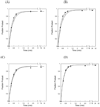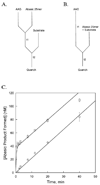Human AP endonuclease 1 stimulates multiple-turnover base excision by alkyladenine DNA glycosylase
- PMID: 19449863
- PMCID: PMC2762795
- DOI: 10.1021/bi900517y
Human AP endonuclease 1 stimulates multiple-turnover base excision by alkyladenine DNA glycosylase
Abstract
Human alkyladenine DNA glycosylase (AAG) locates and excises a wide variety of damaged purine bases from DNA, including hypoxanthine that is formed by the oxidative deamination of adenine. We used steady state, pre-steady state, and single-turnover kinetic assays to show that the multiple-turnover excision of hypoxanthine in vitro is limited by release of the abasic DNA product. This suggests the possibility that the product release step is regulated in vivo by interactions with other base excision repair (BER) proteins. Such coordination of BER activities would protect the abasic DNA repair intermediate and ensure its correct processing. AP endonuclease 1 (APE1) is the predominant enzyme for processing abasic DNA sites in human cells. Therefore, we have investigated the functional effects of added APE1 on the base excision activity of AAG. We find that APE1 stimulates the multiple-turnover excision of hypoxanthine by AAG but has no effect on single-turnover excision. Since the amino terminus of AAG has been implicated in other protein-protein interactions, we also characterize the deletion mutant lacking the first 79 amino acids. We find that APE1 fully stimulates the multiple-turnover glycosylase activity of this mutant, demonstrating that the amino terminus of AAG is not strictly required for this functional interaction. These results are consistent with a model in which APE1 displaces AAG from the abasic site, thereby coordinating the first two steps of the base excision repair pathway.
Figures










Similar articles
-
Nonspecific DNA binding and coordination of the first two steps of base excision repair.Biochemistry. 2010 Sep 14;49(36):7879-91. doi: 10.1021/bi100889r. Biochemistry. 2010. PMID: 20701268 Free PMC article.
-
Slow base excision by human alkyladenine DNA glycosylase limits the rate of formation of AP sites and AP endonuclease 1 does not stimulate base excision.DNA Repair (Amst). 2007 Jan 4;6(1):71-81. doi: 10.1016/j.dnarep.2006.09.001. Epub 2006 Oct 2. DNA Repair (Amst). 2007. PMID: 17018265
-
The role of the N-terminal domain of human apurinic/apyrimidinic endonuclease 1, APE1, in DNA glycosylase stimulation.DNA Repair (Amst). 2018 Apr;64:10-25. doi: 10.1016/j.dnarep.2018.02.001. Epub 2018 Feb 11. DNA Repair (Amst). 2018. PMID: 29475157
-
UV-DDB as a General Sensor of DNA Damage in Chromatin: Multifaceted Approaches to Assess Its Direct Role in Base Excision Repair.Int J Mol Sci. 2023 Jun 15;24(12):10168. doi: 10.3390/ijms241210168. Int J Mol Sci. 2023. PMID: 37373320 Free PMC article. Review.
-
Functions of the major abasic endonuclease (APE1) in cell viability and genotoxin resistance.Mutagenesis. 2020 Feb 13;35(1):27-38. doi: 10.1093/mutage/gez046. Mutagenesis. 2020. PMID: 31816044 Free PMC article. Review.
Cited by
-
An unprecedented nucleic acid capture mechanism for excision of DNA damage.Nature. 2010 Nov 18;468(7322):406-11. doi: 10.1038/nature09428. Epub 2010 Oct 3. Nature. 2010. PMID: 20927102 Free PMC article.
-
Coordination of MYH DNA glycosylase and APE1 endonuclease activities via physical interactions.DNA Repair (Amst). 2013 Dec;12(12):1043-52. doi: 10.1016/j.dnarep.2013.09.007. Epub 2013 Oct 24. DNA Repair (Amst). 2013. PMID: 24209961 Free PMC article.
-
Defining the functional footprint for recognition and repair of deaminated DNA.Nucleic Acids Res. 2012 Dec;40(22):11638-47. doi: 10.1093/nar/gks952. Epub 2012 Oct 15. Nucleic Acids Res. 2012. PMID: 23074184 Free PMC article.
-
Recent advances in the structural mechanisms of DNA glycosylases.Biochim Biophys Acta. 2013 Jan;1834(1):247-71. doi: 10.1016/j.bbapap.2012.10.005. Epub 2012 Oct 14. Biochim Biophys Acta. 2013. PMID: 23076011 Free PMC article. Review.
-
Small-molecule inhibitors of DNA damage-repair pathways: an approach to overcome tumor resistance to alkylating anticancer drugs.Future Med Chem. 2012 Jun;4(9):1093-111. doi: 10.4155/fmc.12.58. Future Med Chem. 2012. PMID: 22709253 Free PMC article. Review.
References
-
- Lindahl T, Wood RD. Quality control by DNA repair. Science. 1999;286:1897–1905. - PubMed
-
- Stivers JT, Jiang YL. A mechanistic perspective on the chemistry of DNA repair glycosylases. Chem Rev. 2003;103:2729–2759. - PubMed
-
- Wood RD, Mitchell M, Lindahl T. Human DNA repair genes. Mutat Res. 2005;577:275–283. - PubMed
Publication types
MeSH terms
Substances
Grants and funding
LinkOut - more resources
Full Text Sources
Other Literature Sources
Research Materials
Miscellaneous

